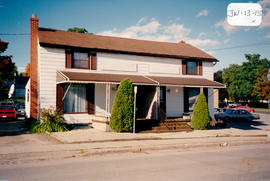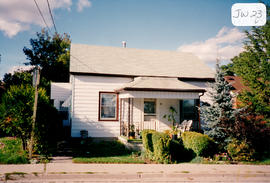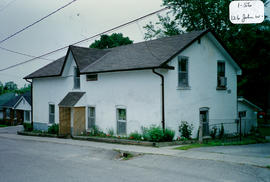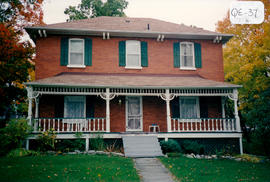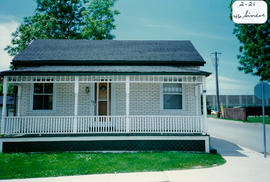- CA BWGPL GJ-HB-2017-04-04-04
- Stuk
- 1996
Part of George Jackson fonds
This mid-block structure is located at 23 and 25 John St. East. It was built around 1830-1860 in the Neoclassical Duplex style. Lewis Algeo, one of the first Irish settlers in West Gwillimbury and a retired farmer, once lived in the west side of the building. T. S. Graham lived in the east side in the early 1900’s. James Glynn lived here around 1916. He left it to James Nolan, son of Denis and Catherine Nolan (reeve of West Gwillimbury), his wife Clare(a piano teacher), and their son, Dennis. The east side was also once the home of Miss Dora Noble, a nurse at the new hospital in Newmarket. She lived here with her retired father (James Noble) until he passed away.
The two-storey, six-bay, semi-detached structure has a rectangular plan with a side hall entrance. It has a two-storey, ‘L’-shaped, rear extension and a medium-pitched, gable roof with chimneys set into each gable end. The formal, symmetrical façade has a series of openings arranged equally across the front. It has paired, entrance doors with side halls along the common, party wall. The raised entrances are set close to the street with side stairs and railings that are not original. Each door has a high transom light set into a plain, rectangular opening. There are large window openings with high floor to ceiling heights. Equal-sized ground and second-floor windows with high sills are set into rectangular openings with plain, wood frames and lug sills. The windows are not original. Wood frame construction is covered with vinyl siding and the building has a cut-stone foundation with a basement. Originally, the cladding was stucco. According to the 2000 inventory, few original details remain other than the building’s form. It also notes that the chimney is not original. An aggressive fire damaged much of the structure on April 6, 2015. Several residents were left homeless as a result of the fire (Bradford Times, April 7, 2015). The structure has since been demolished. (1, 2, 3)
Zonder titel




